Organizational Change Management: Theories, Resistance, and Culture
VerifiedAdded on 2020/02/24
|8
|1910
|110
Essay
AI Summary
This essay delves into the multifaceted realm of organizational change management, exploring the dynamic interplay between various theories and the challenges encountered during implementation. It begins by highlighting the significance of change management in contemporary business environments, emphasizing its role in adapting to market shifts and maintaining competitive advantages. The essay then critically analyzes diverse perspectives on change management, contrasting positive views with those emphasizing complexities and resistance. It examines several models, including Lewin's model and McKinsey's 7S model, providing insights into their applications and effectiveness. A significant portion is dedicated to understanding the role of organizational culture in overcoming resistance to change, underscoring the importance of flexibility, effective communication, and leadership in fostering a smooth transition. The essay concludes by emphasizing the need for a holistic approach that integrates these elements to achieve successful organizational change.
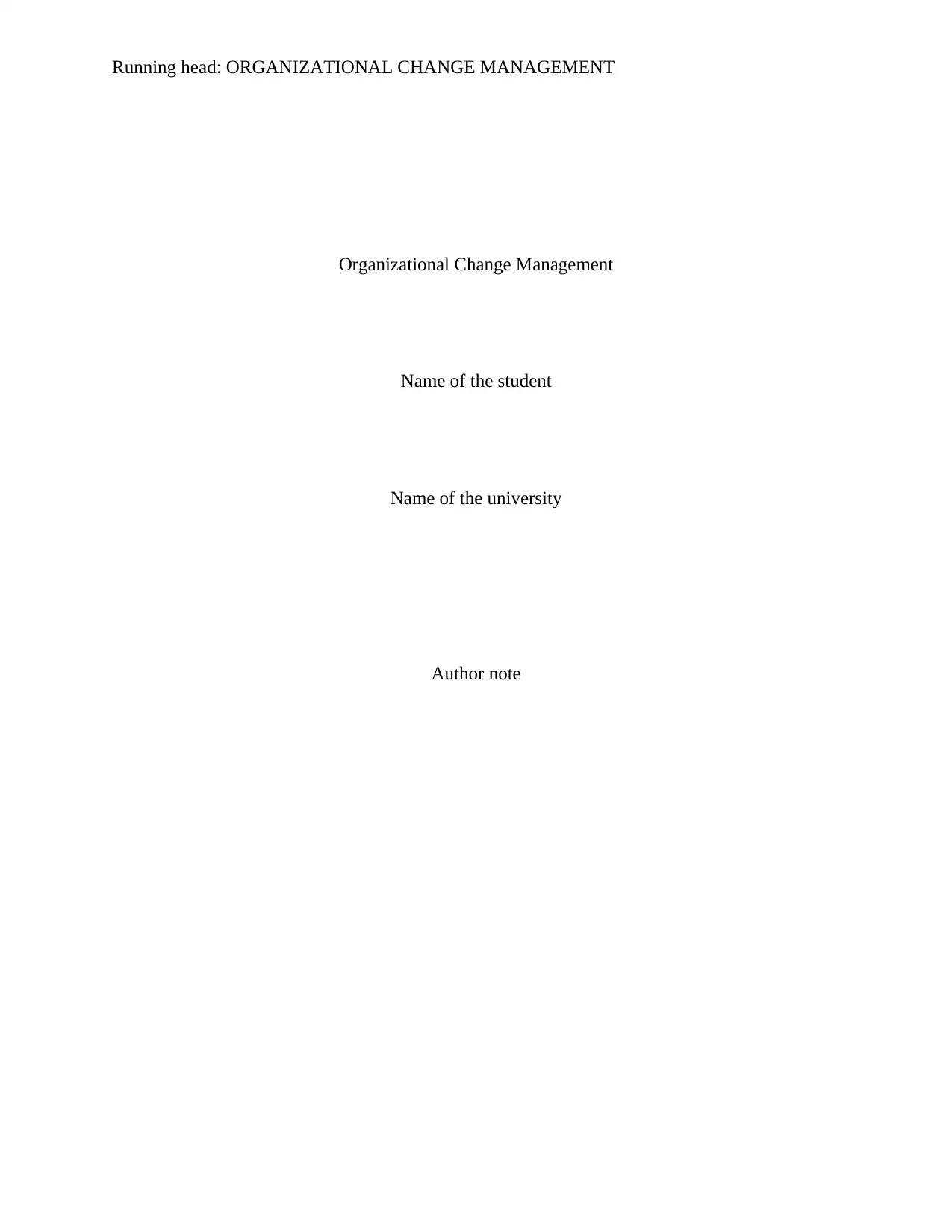
Running head: ORGANIZATIONAL CHANGE MANAGEMENT
Organizational Change Management
Name of the student
Name of the university
Author note
Organizational Change Management
Name of the student
Name of the university
Author note
Paraphrase This Document
Need a fresh take? Get an instant paraphrase of this document with our AI Paraphraser
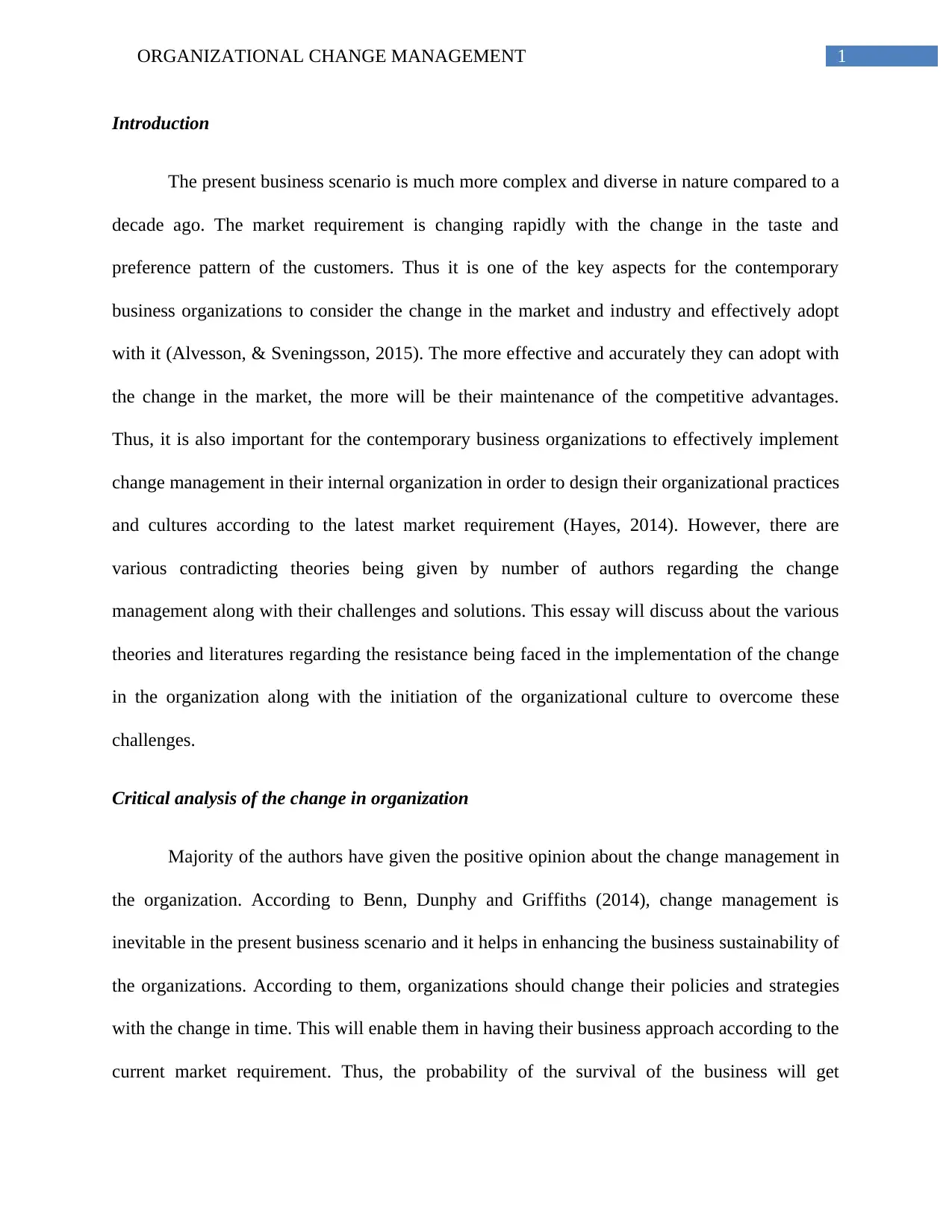
1ORGANIZATIONAL CHANGE MANAGEMENT
Introduction
The present business scenario is much more complex and diverse in nature compared to a
decade ago. The market requirement is changing rapidly with the change in the taste and
preference pattern of the customers. Thus it is one of the key aspects for the contemporary
business organizations to consider the change in the market and industry and effectively adopt
with it (Alvesson, & Sveningsson, 2015). The more effective and accurately they can adopt with
the change in the market, the more will be their maintenance of the competitive advantages.
Thus, it is also important for the contemporary business organizations to effectively implement
change management in their internal organization in order to design their organizational practices
and cultures according to the latest market requirement (Hayes, 2014). However, there are
various contradicting theories being given by number of authors regarding the change
management along with their challenges and solutions. This essay will discuss about the various
theories and literatures regarding the resistance being faced in the implementation of the change
in the organization along with the initiation of the organizational culture to overcome these
challenges.
Critical analysis of the change in organization
Majority of the authors have given the positive opinion about the change management in
the organization. According to Benn, Dunphy and Griffiths (2014), change management is
inevitable in the present business scenario and it helps in enhancing the business sustainability of
the organizations. According to them, organizations should change their policies and strategies
with the change in time. This will enable them in having their business approach according to the
current market requirement. Thus, the probability of the survival of the business will get
Introduction
The present business scenario is much more complex and diverse in nature compared to a
decade ago. The market requirement is changing rapidly with the change in the taste and
preference pattern of the customers. Thus it is one of the key aspects for the contemporary
business organizations to consider the change in the market and industry and effectively adopt
with it (Alvesson, & Sveningsson, 2015). The more effective and accurately they can adopt with
the change in the market, the more will be their maintenance of the competitive advantages.
Thus, it is also important for the contemporary business organizations to effectively implement
change management in their internal organization in order to design their organizational practices
and cultures according to the latest market requirement (Hayes, 2014). However, there are
various contradicting theories being given by number of authors regarding the change
management along with their challenges and solutions. This essay will discuss about the various
theories and literatures regarding the resistance being faced in the implementation of the change
in the organization along with the initiation of the organizational culture to overcome these
challenges.
Critical analysis of the change in organization
Majority of the authors have given the positive opinion about the change management in
the organization. According to Benn, Dunphy and Griffiths (2014), change management is
inevitable in the present business scenario and it helps in enhancing the business sustainability of
the organizations. According to them, organizations should change their policies and strategies
with the change in time. This will enable them in having their business approach according to the
current market requirement. Thus, the probability of the survival of the business will get
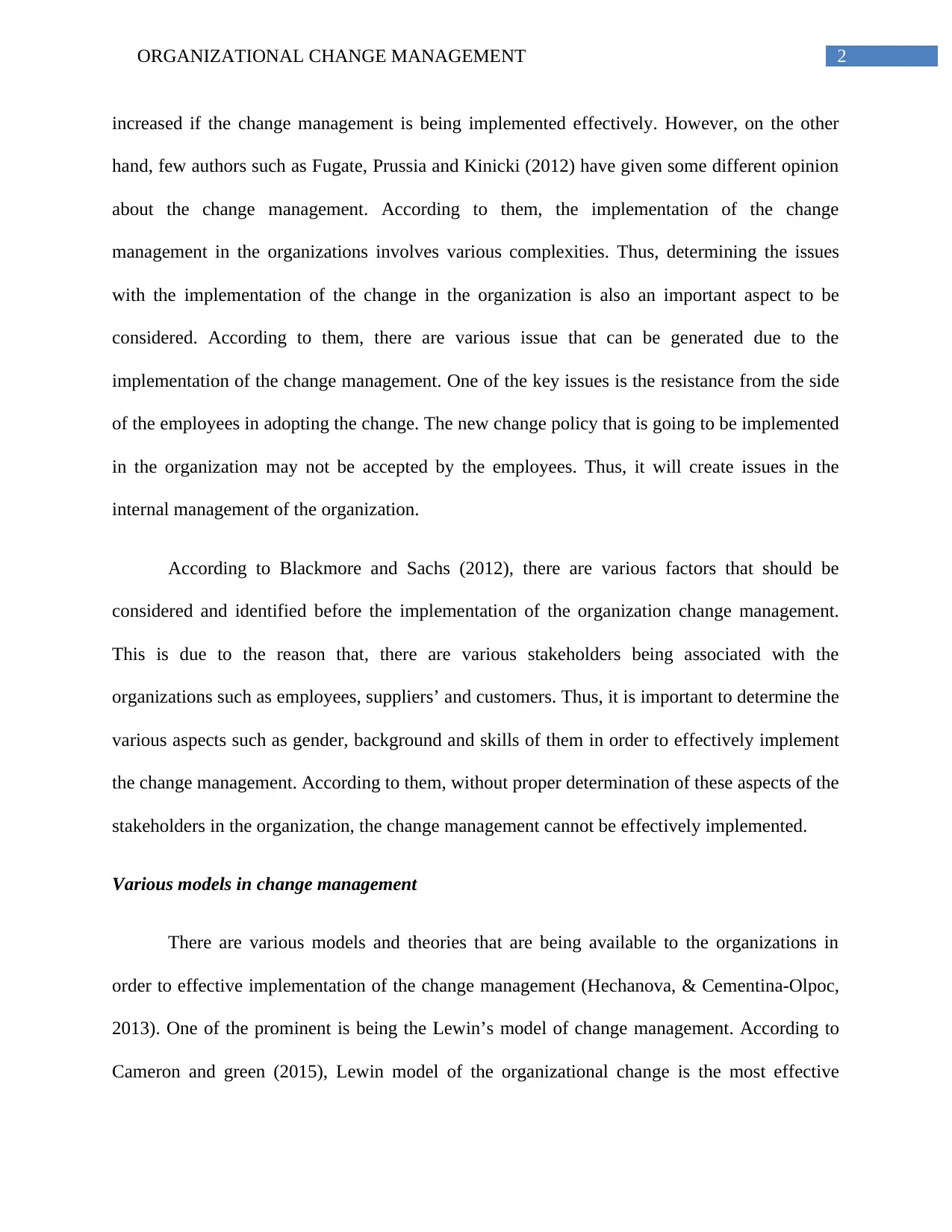
2ORGANIZATIONAL CHANGE MANAGEMENT
increased if the change management is being implemented effectively. However, on the other
hand, few authors such as Fugate, Prussia and Kinicki (2012) have given some different opinion
about the change management. According to them, the implementation of the change
management in the organizations involves various complexities. Thus, determining the issues
with the implementation of the change in the organization is also an important aspect to be
considered. According to them, there are various issue that can be generated due to the
implementation of the change management. One of the key issues is the resistance from the side
of the employees in adopting the change. The new change policy that is going to be implemented
in the organization may not be accepted by the employees. Thus, it will create issues in the
internal management of the organization.
According to Blackmore and Sachs (2012), there are various factors that should be
considered and identified before the implementation of the organization change management.
This is due to the reason that, there are various stakeholders being associated with the
organizations such as employees, suppliers’ and customers. Thus, it is important to determine the
various aspects such as gender, background and skills of them in order to effectively implement
the change management. According to them, without proper determination of these aspects of the
stakeholders in the organization, the change management cannot be effectively implemented.
Various models in change management
There are various models and theories that are being available to the organizations in
order to effective implementation of the change management (Hechanova, & Cementina-Olpoc,
2013). One of the prominent is being the Lewin’s model of change management. According to
Cameron and green (2015), Lewin model of the organizational change is the most effective
increased if the change management is being implemented effectively. However, on the other
hand, few authors such as Fugate, Prussia and Kinicki (2012) have given some different opinion
about the change management. According to them, the implementation of the change
management in the organizations involves various complexities. Thus, determining the issues
with the implementation of the change in the organization is also an important aspect to be
considered. According to them, there are various issue that can be generated due to the
implementation of the change management. One of the key issues is the resistance from the side
of the employees in adopting the change. The new change policy that is going to be implemented
in the organization may not be accepted by the employees. Thus, it will create issues in the
internal management of the organization.
According to Blackmore and Sachs (2012), there are various factors that should be
considered and identified before the implementation of the organization change management.
This is due to the reason that, there are various stakeholders being associated with the
organizations such as employees, suppliers’ and customers. Thus, it is important to determine the
various aspects such as gender, background and skills of them in order to effectively implement
the change management. According to them, without proper determination of these aspects of the
stakeholders in the organization, the change management cannot be effectively implemented.
Various models in change management
There are various models and theories that are being available to the organizations in
order to effective implementation of the change management (Hechanova, & Cementina-Olpoc,
2013). One of the prominent is being the Lewin’s model of change management. According to
Cameron and green (2015), Lewin model of the organizational change is the most effective
⊘ This is a preview!⊘
Do you want full access?
Subscribe today to unlock all pages.

Trusted by 1+ million students worldwide
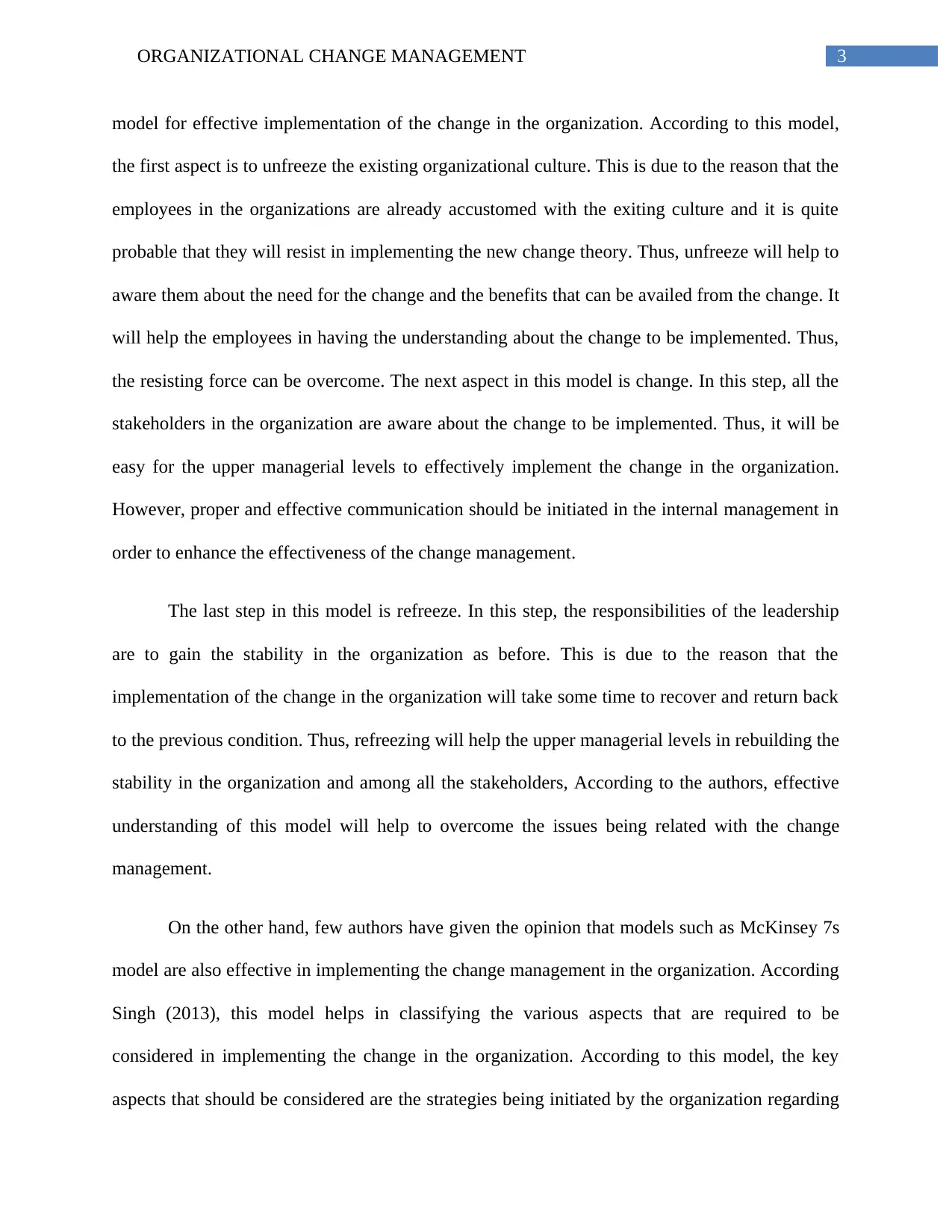
3ORGANIZATIONAL CHANGE MANAGEMENT
model for effective implementation of the change in the organization. According to this model,
the first aspect is to unfreeze the existing organizational culture. This is due to the reason that the
employees in the organizations are already accustomed with the exiting culture and it is quite
probable that they will resist in implementing the new change theory. Thus, unfreeze will help to
aware them about the need for the change and the benefits that can be availed from the change. It
will help the employees in having the understanding about the change to be implemented. Thus,
the resisting force can be overcome. The next aspect in this model is change. In this step, all the
stakeholders in the organization are aware about the change to be implemented. Thus, it will be
easy for the upper managerial levels to effectively implement the change in the organization.
However, proper and effective communication should be initiated in the internal management in
order to enhance the effectiveness of the change management.
The last step in this model is refreeze. In this step, the responsibilities of the leadership
are to gain the stability in the organization as before. This is due to the reason that the
implementation of the change in the organization will take some time to recover and return back
to the previous condition. Thus, refreezing will help the upper managerial levels in rebuilding the
stability in the organization and among all the stakeholders, According to the authors, effective
understanding of this model will help to overcome the issues being related with the change
management.
On the other hand, few authors have given the opinion that models such as McKinsey 7s
model are also effective in implementing the change management in the organization. According
Singh (2013), this model helps in classifying the various aspects that are required to be
considered in implementing the change in the organization. According to this model, the key
aspects that should be considered are the strategies being initiated by the organization regarding
model for effective implementation of the change in the organization. According to this model,
the first aspect is to unfreeze the existing organizational culture. This is due to the reason that the
employees in the organizations are already accustomed with the exiting culture and it is quite
probable that they will resist in implementing the new change theory. Thus, unfreeze will help to
aware them about the need for the change and the benefits that can be availed from the change. It
will help the employees in having the understanding about the change to be implemented. Thus,
the resisting force can be overcome. The next aspect in this model is change. In this step, all the
stakeholders in the organization are aware about the change to be implemented. Thus, it will be
easy for the upper managerial levels to effectively implement the change in the organization.
However, proper and effective communication should be initiated in the internal management in
order to enhance the effectiveness of the change management.
The last step in this model is refreeze. In this step, the responsibilities of the leadership
are to gain the stability in the organization as before. This is due to the reason that the
implementation of the change in the organization will take some time to recover and return back
to the previous condition. Thus, refreezing will help the upper managerial levels in rebuilding the
stability in the organization and among all the stakeholders, According to the authors, effective
understanding of this model will help to overcome the issues being related with the change
management.
On the other hand, few authors have given the opinion that models such as McKinsey 7s
model are also effective in implementing the change management in the organization. According
Singh (2013), this model helps in classifying the various aspects that are required to be
considered in implementing the change in the organization. According to this model, the key
aspects that should be considered are the strategies being initiated by the organization regarding
Paraphrase This Document
Need a fresh take? Get an instant paraphrase of this document with our AI Paraphraser
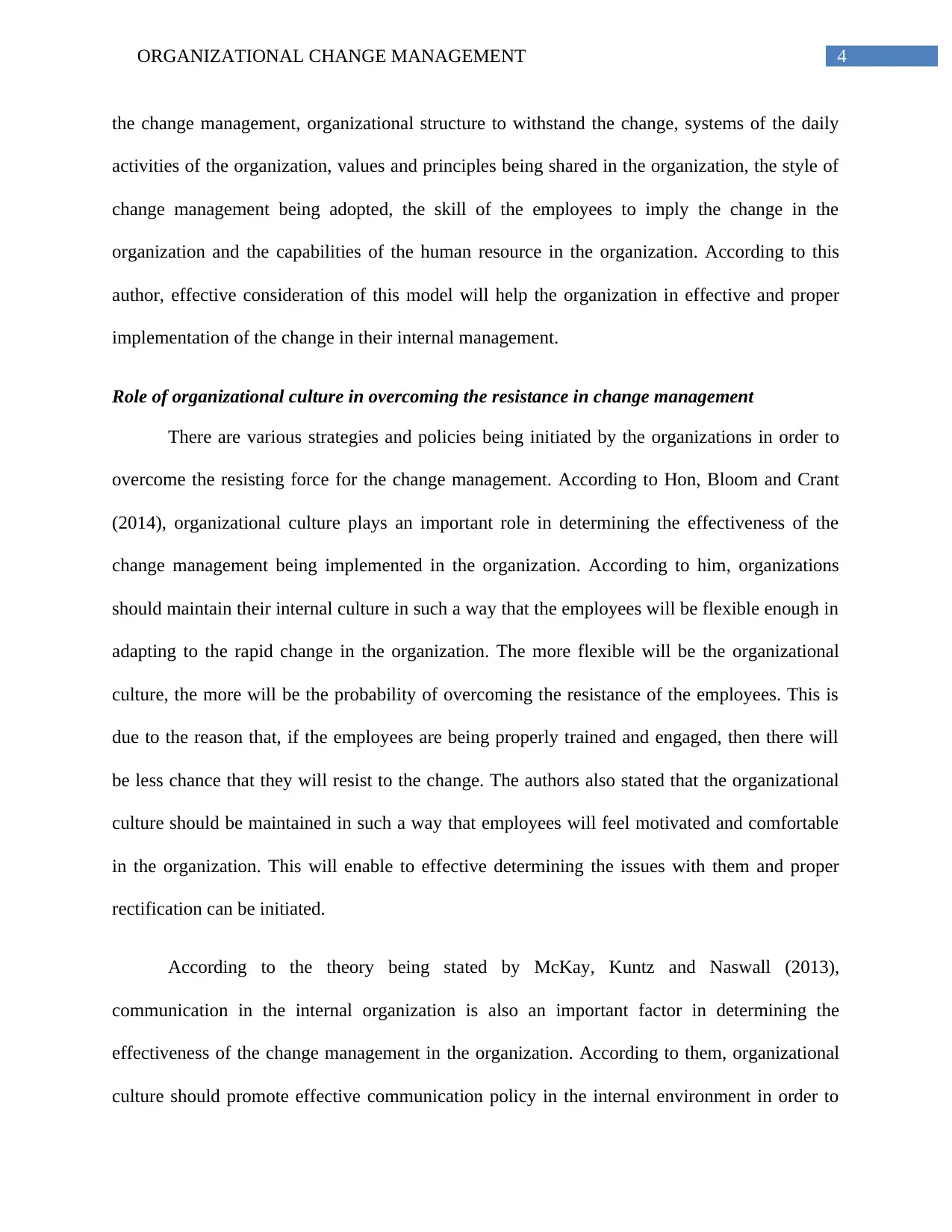
4ORGANIZATIONAL CHANGE MANAGEMENT
the change management, organizational structure to withstand the change, systems of the daily
activities of the organization, values and principles being shared in the organization, the style of
change management being adopted, the skill of the employees to imply the change in the
organization and the capabilities of the human resource in the organization. According to this
author, effective consideration of this model will help the organization in effective and proper
implementation of the change in their internal management.
Role of organizational culture in overcoming the resistance in change management
There are various strategies and policies being initiated by the organizations in order to
overcome the resisting force for the change management. According to Hon, Bloom and Crant
(2014), organizational culture plays an important role in determining the effectiveness of the
change management being implemented in the organization. According to him, organizations
should maintain their internal culture in such a way that the employees will be flexible enough in
adapting to the rapid change in the organization. The more flexible will be the organizational
culture, the more will be the probability of overcoming the resistance of the employees. This is
due to the reason that, if the employees are being properly trained and engaged, then there will
be less chance that they will resist to the change. The authors also stated that the organizational
culture should be maintained in such a way that employees will feel motivated and comfortable
in the organization. This will enable to effective determining the issues with them and proper
rectification can be initiated.
According to the theory being stated by McKay, Kuntz and Naswall (2013),
communication in the internal organization is also an important factor in determining the
effectiveness of the change management in the organization. According to them, organizational
culture should promote effective communication policy in the internal environment in order to
the change management, organizational structure to withstand the change, systems of the daily
activities of the organization, values and principles being shared in the organization, the style of
change management being adopted, the skill of the employees to imply the change in the
organization and the capabilities of the human resource in the organization. According to this
author, effective consideration of this model will help the organization in effective and proper
implementation of the change in their internal management.
Role of organizational culture in overcoming the resistance in change management
There are various strategies and policies being initiated by the organizations in order to
overcome the resisting force for the change management. According to Hon, Bloom and Crant
(2014), organizational culture plays an important role in determining the effectiveness of the
change management being implemented in the organization. According to him, organizations
should maintain their internal culture in such a way that the employees will be flexible enough in
adapting to the rapid change in the organization. The more flexible will be the organizational
culture, the more will be the probability of overcoming the resistance of the employees. This is
due to the reason that, if the employees are being properly trained and engaged, then there will
be less chance that they will resist to the change. The authors also stated that the organizational
culture should be maintained in such a way that employees will feel motivated and comfortable
in the organization. This will enable to effective determining the issues with them and proper
rectification can be initiated.
According to the theory being stated by McKay, Kuntz and Naswall (2013),
communication in the internal organization is also an important factor in determining the
effectiveness of the change management in the organization. According to them, organizational
culture should promote effective communication policy in the internal environment in order to
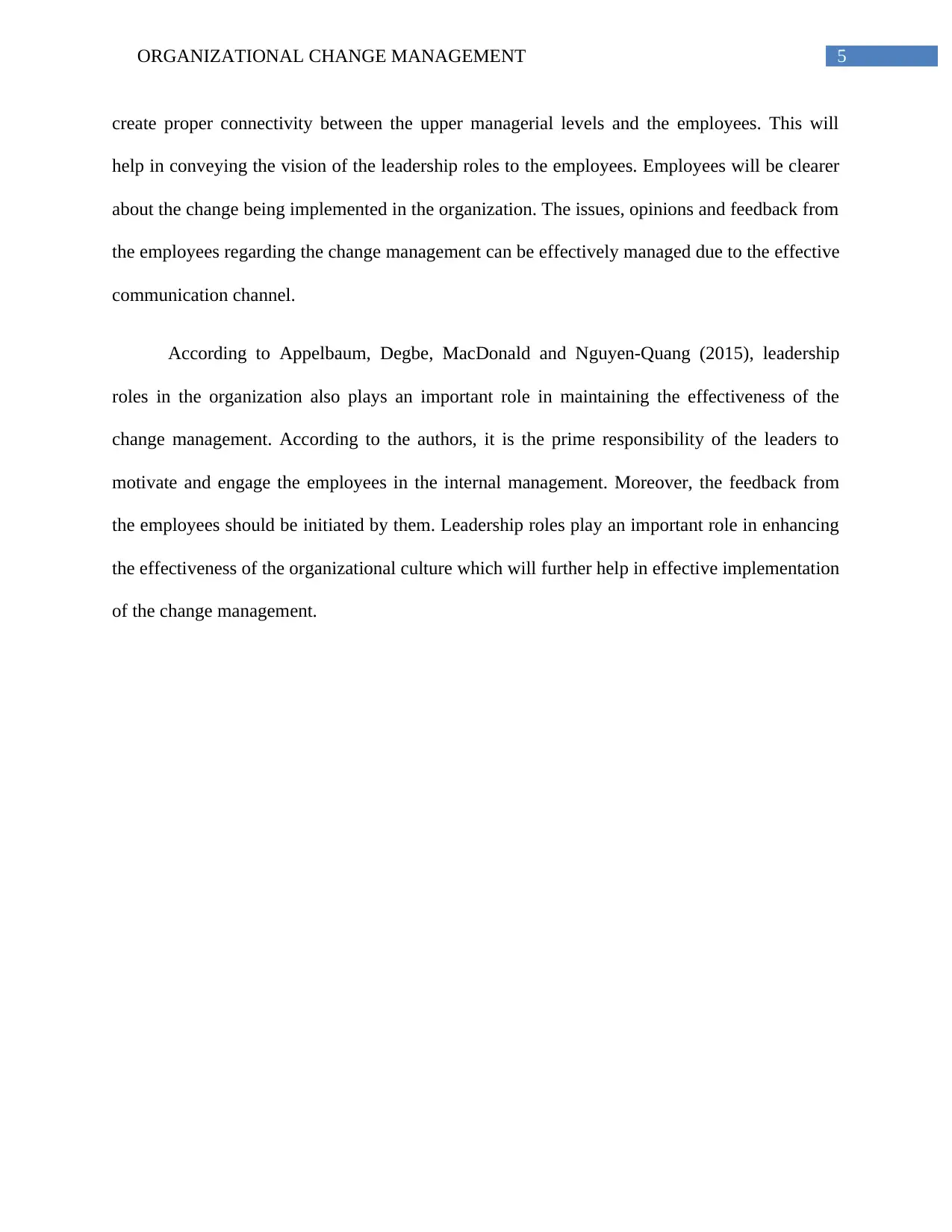
5ORGANIZATIONAL CHANGE MANAGEMENT
create proper connectivity between the upper managerial levels and the employees. This will
help in conveying the vision of the leadership roles to the employees. Employees will be clearer
about the change being implemented in the organization. The issues, opinions and feedback from
the employees regarding the change management can be effectively managed due to the effective
communication channel.
According to Appelbaum, Degbe, MacDonald and Nguyen-Quang (2015), leadership
roles in the organization also plays an important role in maintaining the effectiveness of the
change management. According to the authors, it is the prime responsibility of the leaders to
motivate and engage the employees in the internal management. Moreover, the feedback from
the employees should be initiated by them. Leadership roles play an important role in enhancing
the effectiveness of the organizational culture which will further help in effective implementation
of the change management.
create proper connectivity between the upper managerial levels and the employees. This will
help in conveying the vision of the leadership roles to the employees. Employees will be clearer
about the change being implemented in the organization. The issues, opinions and feedback from
the employees regarding the change management can be effectively managed due to the effective
communication channel.
According to Appelbaum, Degbe, MacDonald and Nguyen-Quang (2015), leadership
roles in the organization also plays an important role in maintaining the effectiveness of the
change management. According to the authors, it is the prime responsibility of the leaders to
motivate and engage the employees in the internal management. Moreover, the feedback from
the employees should be initiated by them. Leadership roles play an important role in enhancing
the effectiveness of the organizational culture which will further help in effective implementation
of the change management.
⊘ This is a preview!⊘
Do you want full access?
Subscribe today to unlock all pages.

Trusted by 1+ million students worldwide
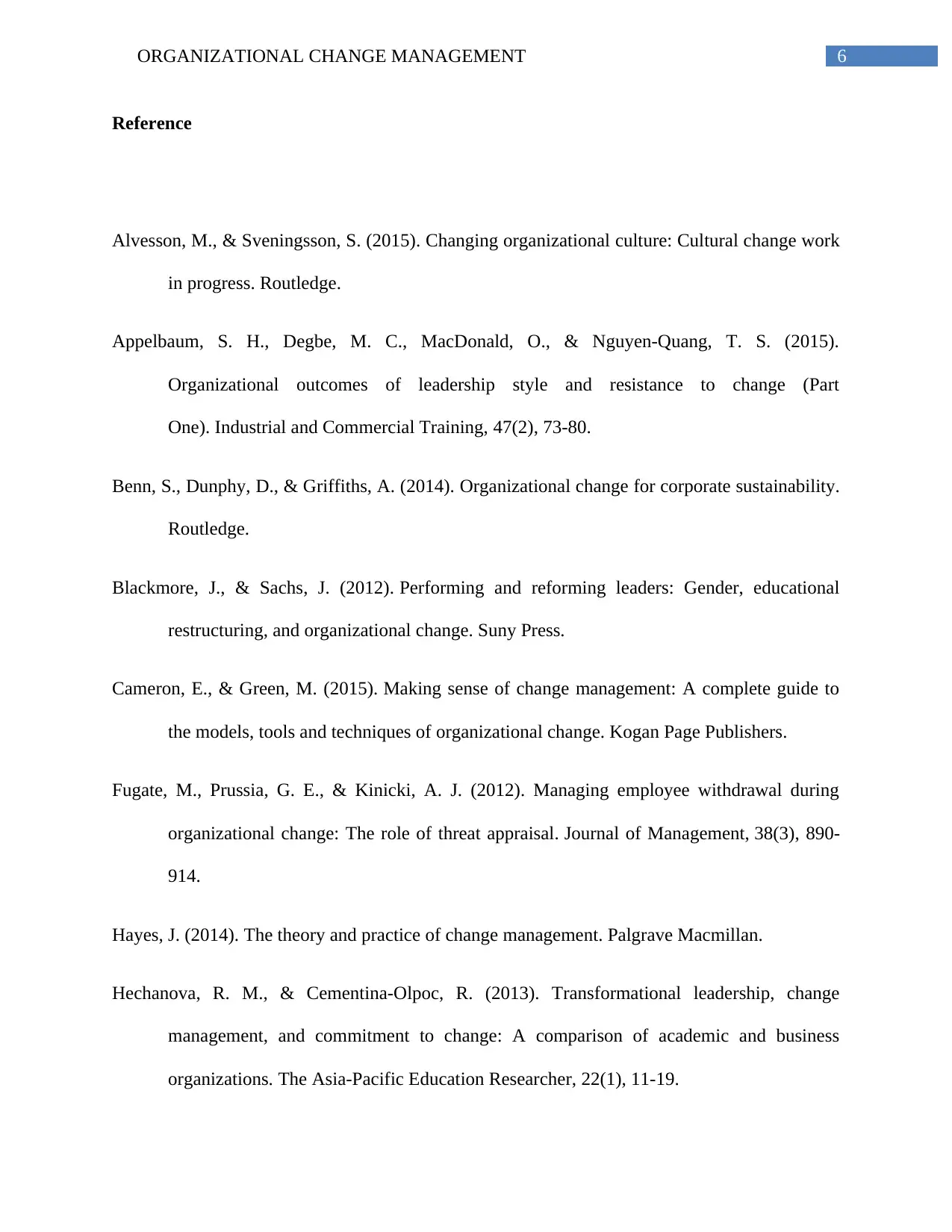
6ORGANIZATIONAL CHANGE MANAGEMENT
Reference
Alvesson, M., & Sveningsson, S. (2015). Changing organizational culture: Cultural change work
in progress. Routledge.
Appelbaum, S. H., Degbe, M. C., MacDonald, O., & Nguyen-Quang, T. S. (2015).
Organizational outcomes of leadership style and resistance to change (Part
One). Industrial and Commercial Training, 47(2), 73-80.
Benn, S., Dunphy, D., & Griffiths, A. (2014). Organizational change for corporate sustainability.
Routledge.
Blackmore, J., & Sachs, J. (2012). Performing and reforming leaders: Gender, educational
restructuring, and organizational change. Suny Press.
Cameron, E., & Green, M. (2015). Making sense of change management: A complete guide to
the models, tools and techniques of organizational change. Kogan Page Publishers.
Fugate, M., Prussia, G. E., & Kinicki, A. J. (2012). Managing employee withdrawal during
organizational change: The role of threat appraisal. Journal of Management, 38(3), 890-
914.
Hayes, J. (2014). The theory and practice of change management. Palgrave Macmillan.
Hechanova, R. M., & Cementina-Olpoc, R. (2013). Transformational leadership, change
management, and commitment to change: A comparison of academic and business
organizations. The Asia-Pacific Education Researcher, 22(1), 11-19.
Reference
Alvesson, M., & Sveningsson, S. (2015). Changing organizational culture: Cultural change work
in progress. Routledge.
Appelbaum, S. H., Degbe, M. C., MacDonald, O., & Nguyen-Quang, T. S. (2015).
Organizational outcomes of leadership style and resistance to change (Part
One). Industrial and Commercial Training, 47(2), 73-80.
Benn, S., Dunphy, D., & Griffiths, A. (2014). Organizational change for corporate sustainability.
Routledge.
Blackmore, J., & Sachs, J. (2012). Performing and reforming leaders: Gender, educational
restructuring, and organizational change. Suny Press.
Cameron, E., & Green, M. (2015). Making sense of change management: A complete guide to
the models, tools and techniques of organizational change. Kogan Page Publishers.
Fugate, M., Prussia, G. E., & Kinicki, A. J. (2012). Managing employee withdrawal during
organizational change: The role of threat appraisal. Journal of Management, 38(3), 890-
914.
Hayes, J. (2014). The theory and practice of change management. Palgrave Macmillan.
Hechanova, R. M., & Cementina-Olpoc, R. (2013). Transformational leadership, change
management, and commitment to change: A comparison of academic and business
organizations. The Asia-Pacific Education Researcher, 22(1), 11-19.
Paraphrase This Document
Need a fresh take? Get an instant paraphrase of this document with our AI Paraphraser
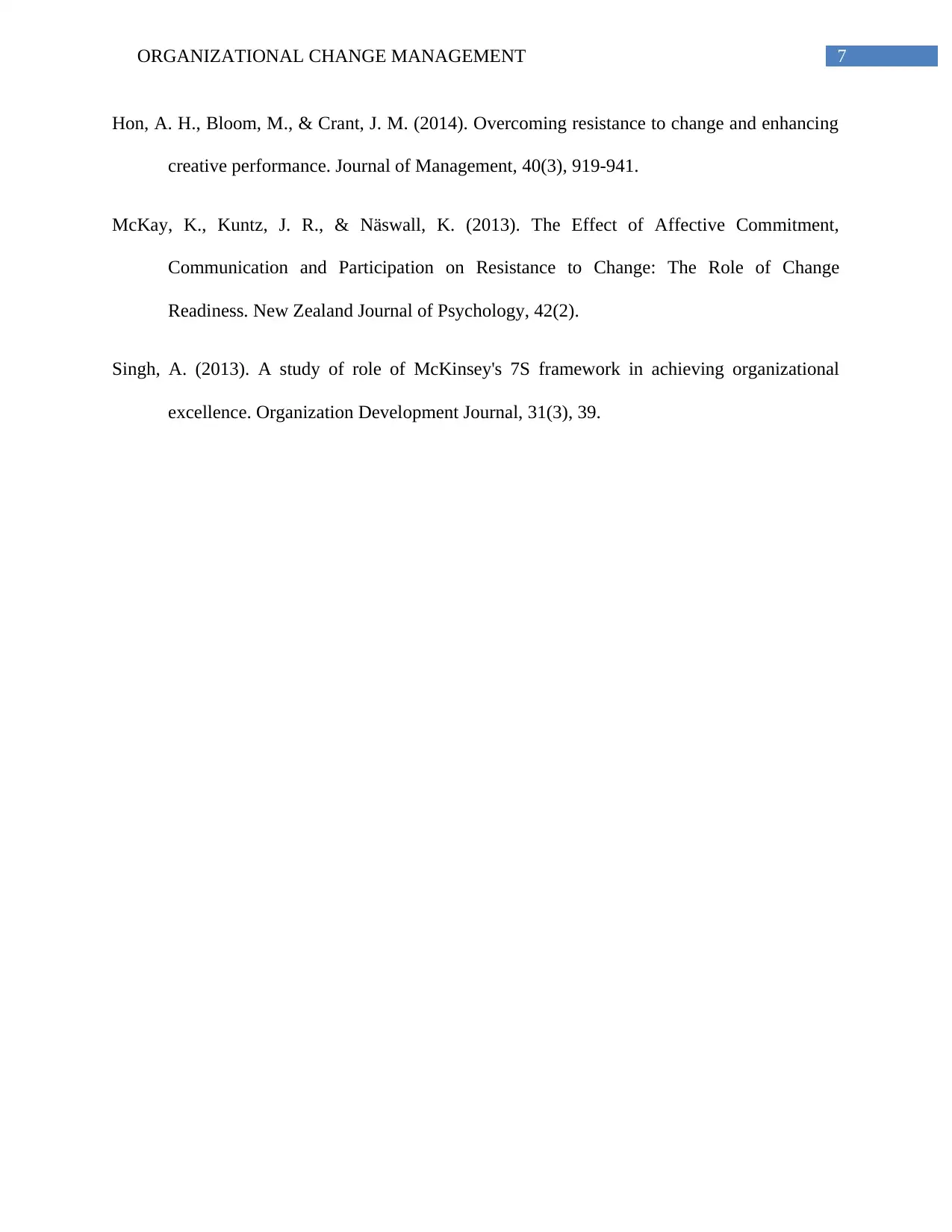
7ORGANIZATIONAL CHANGE MANAGEMENT
Hon, A. H., Bloom, M., & Crant, J. M. (2014). Overcoming resistance to change and enhancing
creative performance. Journal of Management, 40(3), 919-941.
McKay, K., Kuntz, J. R., & Näswall, K. (2013). The Effect of Affective Commitment,
Communication and Participation on Resistance to Change: The Role of Change
Readiness. New Zealand Journal of Psychology, 42(2).
Singh, A. (2013). A study of role of McKinsey's 7S framework in achieving organizational
excellence. Organization Development Journal, 31(3), 39.
Hon, A. H., Bloom, M., & Crant, J. M. (2014). Overcoming resistance to change and enhancing
creative performance. Journal of Management, 40(3), 919-941.
McKay, K., Kuntz, J. R., & Näswall, K. (2013). The Effect of Affective Commitment,
Communication and Participation on Resistance to Change: The Role of Change
Readiness. New Zealand Journal of Psychology, 42(2).
Singh, A. (2013). A study of role of McKinsey's 7S framework in achieving organizational
excellence. Organization Development Journal, 31(3), 39.
1 out of 8
Related Documents
Your All-in-One AI-Powered Toolkit for Academic Success.
+13062052269
info@desklib.com
Available 24*7 on WhatsApp / Email
![[object Object]](/_next/static/media/star-bottom.7253800d.svg)
Unlock your academic potential
Copyright © 2020–2025 A2Z Services. All Rights Reserved. Developed and managed by ZUCOL.





